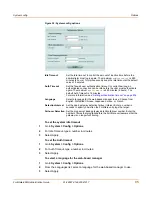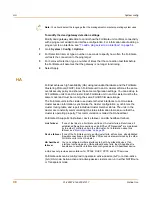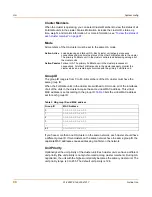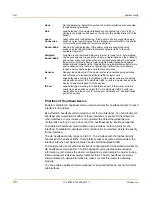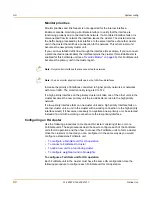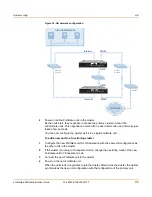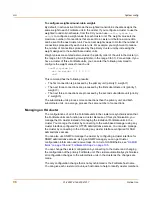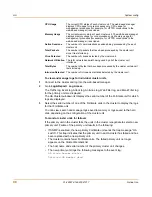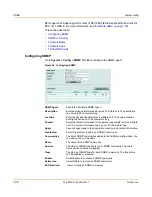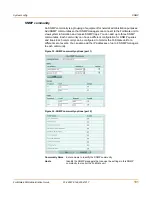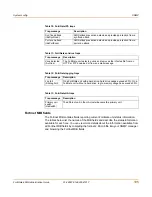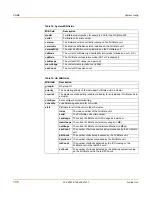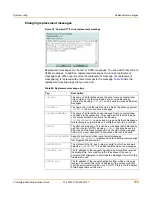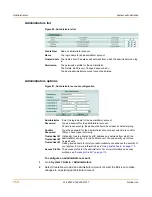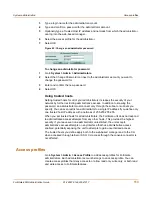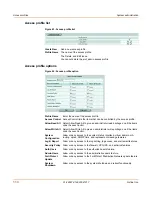
System config
SNMP
FortiGate-60M Administration Guide
01-28007-0144-20041217
99
If a subordinate unit fails, the cluster continues to function normally. Failure of a
subordinate unit results in the following:
• The cluster contains fewer FortiGate units. The failed unit no longer appears on the
Cluster Members list.
• The master unit logs the following message to the event log:
Detected HA member dead
To manage individual cluster units
This procedure describes how to log into the primary unit CLI and from there to
connect to the CLI of subordinate cluster units. You log into the subordinate unit using
the ha_admin administrator account. This built-in administrator account gives you
read and write permission on the subordinate unit.
1
Use SSH to connect to the cluster and log into the CLI.
Connect to any cluster interface configured for SSH administrative access to log into
the cluster.
You can also use a direct cable connection to log into the primary unit CLI. To do this
you must know which unit is the primary unit.
2
Enter the following command followed by a space and type a question mark (
?
):
execute ha manage
The CLI displays a list of all the subordinate units in the cluster. Each cluster unit is
numbered, starting at 1. The information displayed for each cluster unit includes the
unit serial number and the host name of the unit.
3
Complete the command with the number of the subordinate unit to log into. For
example, to log into subordinate unit 1, enter the following command:
execute ha manage 1
Press Enter to connect to and log into the CLI of the selected subordinate unit. If this
subordinate unit has a different host name, the CLI prompt changes to this host name.
You can use CLI commands to manage this subordinate unit.
4
Enter the following command to return to the primary unit CLI:
exit
You can use the
execute ha manage
command to log into the CLI of any of the
other subordinate units in the cluster.
SNMP
You can configure the FortiGate SNMP agent to report system information and send
traps (alarms or event messages) to SNMP managers. Using an SNMP manager, you
can access SNMP traps and data from any FortiGate interface or VLAN subinterface
configured for SNMP management access.
The FortiGate SNMP implementation is read-only. SNMP v1 and v2c compliant SNMP
managers have read-only access to FortiGate system information and can receive
FortiGate traps. To monitor FortiGate system information and receive FortiGate traps
you must compile Fortinet proprietary MIBs as well as Fortinet-supported standard
MIBs into your SNMP manager.
Summary of Contents for FortiGate FortiGate-60M
Page 12: ...Contents 12 01 28007 0144 20041217 Fortinet Inc Index 369 ...
Page 44: ...44 01 28007 0144 20041217 Fortinet Inc Changing the FortiGate firmware System status ...
Page 74: ...74 01 28007 0144 20041217 Fortinet Inc FortiGate IPv6 support System network ...
Page 82: ...82 01 28007 0144 20041217 Fortinet Inc Dynamic IP System DHCP ...
Page 116: ...116 01 28007 0144 20041217 Fortinet Inc Access profiles System administration ...
Page 234: ...234 01 28007 0144 20041217 Fortinet Inc Protection profile Firewall ...
Page 246: ...246 01 28007 0144 20041217 Fortinet Inc CLI configuration Users and authentication ...
Page 278: ...278 01 28007 0144 20041217 Fortinet Inc CLI configuration VPN ...
Page 340: ...340 01 28007 0144 20041217 Fortinet Inc Using Perl regular expressions Spam filter ...
Page 358: ...358 01 28007 0144 20041217 Fortinet Inc CLI configuration Log Report ...
Page 376: ...376 01 28007 0144 20041217 Fortinet Inc Index ...

